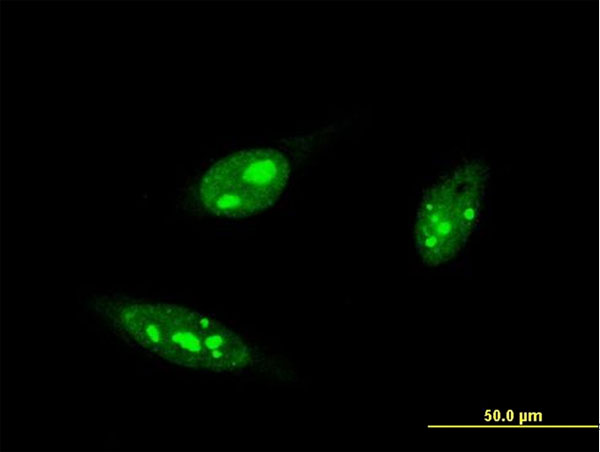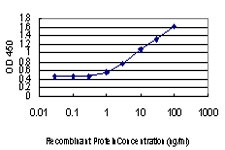IRF4 Antibody (monoclonal) (M05)
Mouse monoclonal antibody raised against a partial recombinant IRF4.
- SPECIFICATION
- CITATIONS
- PROTOCOLS
- BACKGROUND

Application
| WB, IF, E |
|---|---|
| Primary Accession | Q15306 |
| Other Accession | NM_002460 |
| Reactivity | Human |
| Host | mouse |
| Clonality | Monoclonal |
| Isotype | IgG2b Kappa |
| Clone Names | 2D1 |
| Calculated MW | 51772 Da |
| Gene ID | 3662 |
|---|---|
| Other Names | Interferon regulatory factor 4, IRF-4, Lymphocyte-specific interferon regulatory factor, LSIRF, Multiple myeloma oncogene 1, NF-EM5, IRF4, MUM1 |
| Target/Specificity | IRF4 (NP_002451, 342 a.a. ~ 451 a.a) partial recombinant protein with GST tag. MW of the GST tag alone is 26 KDa. |
| Dilution | WB~~1:500~1000 IF~~1:50~200 E~~N/A |
| Format | Clear, colorless solution in phosphate buffered saline, pH 7.2 . |
| Storage | Store at -20°C or lower. Aliquot to avoid repeated freezing and thawing. |
| Precautions | IRF4 Antibody (monoclonal) (M05) is for research use only and not for use in diagnostic or therapeutic procedures. |

Thousands of laboratories across the world have published research that depended on the performance of antibodies from Abcepta to advance their research. Check out links to articles that cite our products in major peer-reviewed journals, organized by research category.
info@abcepta.com, and receive a free "I Love Antibodies" mug.
Provided below are standard protocols that you may find useful for product applications.
Background
The protein encoded by this gene belongs to the IRF (interferon regulatory factor) family of transcription factors, characterized by an unique tryptophan pentad repeat DNA-binding domain. The IRFs are important in the regulation of interferons in response to infection by virus, and in the regulation of interferon-inducible genes. This family member is lymphocyte specific and negatively regulates Toll-like-receptor (TLR) signaling that is central to the activation of innate and adaptive immune systems. A chromosomal translocation involving this gene and the IgH locus, t(6;14)(p25;q32), may be a cause of multiple myeloma. Alternatively spliced transcript variants have been found for this gene.
References
Interferon-regulatory factor 4 is essential for the developmental program of T helper 9 cells. Staudt V, et al. Immunity, 2010 Aug 27. PMID 20674401.Melanocytic nevi, nevus genes, and melanoma risk in a large case-control study in the United Kingdom. Newton-Bishop JA, et al. Cancer Epidemiol Biomarkers Prev, 2010 Aug. PMID 20647408.IRF4 variants have age-specific effects on nevus count and predispose to melanoma. Duffy DL, et al. Am J Hum Genet, 2010 Jul 9. PMID 20602913.Examination of genetic polymorphisms in newborns for signatures of sex-specific prenatal selection. Ucisik-Akkaya E, et al. Mol Hum Reprod, 2010 Oct. PMID 20587610.Web-based, participant-driven studies yield novel genetic associations for common traits. Eriksson N, et al. PLoS Genet, 2010 Jun 24. PMID 20585627.
If you have used an Abcepta product and would like to share how it has performed, please click on the "Submit Review" button and provide the requested information. Our staff will examine and post your review and contact you if needed.
If you have any additional inquiries please email technical services at tech@abcepta.com.













 Foundational characteristics of cancer include proliferation, angiogenesis, migration, evasion of apoptosis, and cellular immortality. Find key markers for these cellular processes and antibodies to detect them.
Foundational characteristics of cancer include proliferation, angiogenesis, migration, evasion of apoptosis, and cellular immortality. Find key markers for these cellular processes and antibodies to detect them. The SUMOplot™ Analysis Program predicts and scores sumoylation sites in your protein. SUMOylation is a post-translational modification involved in various cellular processes, such as nuclear-cytosolic transport, transcriptional regulation, apoptosis, protein stability, response to stress, and progression through the cell cycle.
The SUMOplot™ Analysis Program predicts and scores sumoylation sites in your protein. SUMOylation is a post-translational modification involved in various cellular processes, such as nuclear-cytosolic transport, transcriptional regulation, apoptosis, protein stability, response to stress, and progression through the cell cycle. The Autophagy Receptor Motif Plotter predicts and scores autophagy receptor binding sites in your protein. Identifying proteins connected to this pathway is critical to understanding the role of autophagy in physiological as well as pathological processes such as development, differentiation, neurodegenerative diseases, stress, infection, and cancer.
The Autophagy Receptor Motif Plotter predicts and scores autophagy receptor binding sites in your protein. Identifying proteins connected to this pathway is critical to understanding the role of autophagy in physiological as well as pathological processes such as development, differentiation, neurodegenerative diseases, stress, infection, and cancer.






